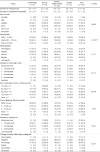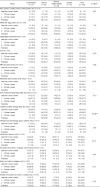1. World Health Organization. Overweight and obesity. Geneva: World Health Organization;2017.
2. Oliveros E, Somers VK, Sochor O, Goel K, Lopez-Jimenez F. The concept of normal weight obesity. Prog Cardiovasc Dis. 2014; 56(4):426–433.

3. Franco LP, Morais CC, Cominetti C. Normal-weight obesity syndrome: Diagnosis, prevalence, and clinical implications. Nutr Rev. 2016; 74(9):558–570.

4. Burkhauser RV, Cawley J. Beyond BMI: The value of more accurate measures of fatness and obesity in social science research. J Health Econ. 2008; 27(2):519–529.

5. Ko JH, Kim KJ. Comparison of body composition according to the obesity types based upon percent body fat, BMI and waist circumference in women. Korean J Growth Dev. 2007; 15(1):1–7.
6. Lorenzo A, Martinoli R, Vaia F, Di Renzo L. Normal weight obese (NWO) women: An evaluation of a candidate new syndrome. Nutr Metab Cardiovasc Dis. 2006; 16(8):513–523.
7. Kim MK, Han KD, Kwon HS, Song KH, Yim HW, Lee WC, et al. Normal weight obesity in Korean adults. Clin Endocrinol. 2014; 80(2):214–220.

8. Chaung SK. Body mass index and waist circumference for screening obesity in young adult women. J Korean Acad Fundam Nurs. 2009; 16(1):14–20.
9. Dalton M, Cameron A, Zimmet P, Shaw J, Jolley D, Dunstan D, et al. Waist circumference, waist-hip ratio and body mass index and their correlation with cardiovascular disease risk factors in Australian adults. J Intern Med. 2003; 254(6):555–563.

10. Han JH, Kim SM. Relationship between percent body fat and cardiovascular risk factors for normal weight adults. J Korean Acad Fam Med. 2006; 27(5):352–357.
11. Ito H, Nakasuga K, Ohshima A, Sakai Y, Maruyama T, Kaji Y, et al. Excess accumulation of body fat is related to dyslipidemia in normal-weight subjects. Int J Obes Relat Metab Disrod. 2004; 28(2):242–247.

12. Kishimoto N, Okita K, Takada S, Sakuma I, Saijo Y, Chiba H, et al. Lipoprotein metabolism, insulin resistance, and adipocytokine levels in Japanese female adolescents with a normal body mass index and high body fat mass. Circ J. 2009; 73(3):534–539.

13. Tanaka S, Togashi K, Rankinen T, PErusse L, Leon AS, Rao DC, et al. Is adiposity at normal body weight relevant for cardiovascular disease risk? Int J Obes Relat Metab Dsord. 2002; 26(2):176.

14. Romero-Corral A, Somers VK, Sierra-Johnson J, Korenfeld Y, Boarin S, Korinek J, et al. Normal weight obesity: A risk factor for cardiometabolic dysregulation and cardiovascular mortality. Eur Heart J. 2009; 31(6):737–746.

15. Ruderman NB, Schneider SH, Berchtold P. The “metabolicallyobese,” normal-weight individual. Am J Clin Nutr. 1981; 34(8):1617–1621.

16. Ruderman N, Chisholm D, Pi-Sunyer X, Schneider S. The metabolically obese, normal-weight individual revisited. Diabetes. 1998; 47(5):699–713.

17. Lee KY. Metabolically obese but normal weight (MONW) and metabolically healthy but obese (MHO) phenotypes in Koreans: Characteristics and health behaviors. Asia Pac J Clin Nutr. 2009; 18(2):280–284.
18. Min SH, Oh HS, Kim JH. Dietary behaviors and perceived stress of university students. Korean J Food Culture. 2004; 19(2):158–169.
19. Kim YM, Kim MH. A study of the osteoporosis-related lifestyle and health promotion behavior of university and college female student. J Rheumatol. 2002; 9(1):53–67.
20. Ministry of Health & Welfare, Korea Centers for Disease Control and Prevention. Korean National Health and Nutrition Examination survey 2016. Sejong: Ministry of Health & Welfare;2017.
21. Di Renzo L, Galvano F, Orlandi C, Bianchi A, Di Giacomo C, La Fauci, et al. Oxidative stress in normal-weight obese syndrome. Obesity. 2010; 18(11):2125–2130.

22. Dvorak RV, DeNino WF, Ades PA, Poehlman ET. Phenotypic characteristics associated with insulin resistance in metabolically obese but normal-weight young women. Diabetes. 1999; 48(11):2210–2214.

23. Choi KS, Shin KO, Huh SM, Chung KH. Analysis of dietary habits by MDA (mini dietary assessment) score and physical development and blood parameters in female college students in Seoul area. J East Asian Soc Diet Life. 2009; 19(6):856–868.
24. Yoo JH, Jo HS. The effects of a compound exercise and a walking exercise program on body composition, perceived health status, and stress for thin-obesity college women. J Korean Soc Health Educ Promot. 2009; 26(4):91–103.
25. Sim SJ, Park HS. The cut-off values of body fat to identify cardiovascular risk among Korean adults. J Obes Metab Syndr. 2004; 13(1):14–21.
26. Marques-Vidal P, PÉcoud A, Hayoz D, Paccaud F, Mooser V, Waeber G, Vollenweider P. Normal weight obesity: Relationship with lipids, glycaemic status, liver enzymes and inflammation. Nutr Metab Cardiovasc Dis. 2010; 20(9):669–675.

27. Ahn BRM, Park ES. Perception of body weight control, life styles, and dietary habits according to the obesity index (OI) of female college students. Korean J Hum Ecol. 2009; 18(1):167–179.
28. Madeira FB, Silva AA, Veloso HF, Goldani MZ, Kac G, Cardoso VC, et al. Normal weight obesity is associated with metabolic syndrome and insulin resistance in young adults from a middleincome country. PLoS One. 2013; 8(3):e60673.

29. Kim JY, Han SH, Yang BM. Implication of high-body-fat percentage on cardiometabolic risk in middle-aged, healthy, normal-weight adults. Obesity. 2013; 21(8):1571–1577.

30. Milano W, De Rosa M, Milano L, Capasso A. Night eating syndrome: an overview. J Pharm Pharmacol. 2012; 64(1):2–10.

31. Gallant AR, Lundgren J, Drapeau V. The night-eating syndrome and obesity. Obes Rev. 2012; 13(6):528–536.

32. Marinac CR, Sears DD, Natarajan L, Gallo LC, Breen CI, Patterson RE. Frequency and circadian timing of eating may influence biomarkers of inflammation and insulin resistance associated with breast cancer risk. PLoS One. 2015; 10(8):e0136240.

33. Fisch IR, Freedman SH. Smoking, oral contraceptives, and obesity: Effects on white blood cell count. JAMA. 1975; 234(5):500–506.

34. Fantuzzi G. Adipose tissue, adipokines, and inflammation. J Allergy Clin Immunol. 2005; 115(5):911–919.

35. Lee YH, Pratley RE. The evolving role of inflammation in obesity and the metabolic syndrome. Curr Diab Rep. 2005; 5(1):70–75.

36. Capuano V, Lamaida N, Mazzotta G, Scotto di Quacquaro G. Relation between white blood cell count and several risk factors for coronary heart disease in patients with systemic hypertension. G Ital Cardiol. 1998; 28(5):530–535.
37. Nagasawa N, Tamakoshi K, Yatsuya H, Hori Y, Ishikawa M, Murata C, et al. Association of white blood cell count and clustered components of metabolic syndrome in Japanese men. Circ J. 2004; 68(10):892–897.

38. Yaegashi M, Jean R, Zuriqat M, Noack S, Homel P. Outcome of morbid obesity in the intensive care unit. J Intensive Care Med. 2005; 20(3):147–154.

39. Wolk A, Gridley G, Svensson M, Nyren O, McLaughlin JK, Fraumeni JF, et al. A prospective study of obesity and cancer risk (Sweden). Cancer Causes Control. 2001; 12(1):13–21.
40. Veronelli A, Laneri M, Ranieri R, Koprivec D, Vardaro D, Paganelli M, et al. White blood cells in obesity and diabetes: Effects of weight loss and normalization of glucose metabolism. Diabetes Care. 2004; 27(10):2501–2502.

41. Ziccardi P, Nappo F, Giugliano G, Esposito K, Marfella R, Cioffi M, et al. Reduction of inflammatory cytokine concentrations and improvement of endothelial functions in obese women after weight loss over one year. Circulation. 2002; 105(7):804–809.

42. Mokdad AH, Ford ES, Bowman BA, Dietz WH, Vinicor F, Bales VS, et al. Prevalence of obesity, diabetes, and obesityrelated health risk factors, 2001. JAMA. 2003; 289(1):76–79.

43. Must A, Spadano J, Coakley EH, Field AE, Colditz G, Dietz WH. The disease burden associated with overweight and obesity. JAMA. 1999; 282(16):1523–1529.

44. Kim SH, Kyung CH, Park JS, Lee SP, Kim HK, Ahn CW, et al. Normal-weight obesity is associated with increased risk of subclinical atherosclerosis. Cardiovasc Diabetol. 2015; 14(1):58.








 PDF
PDF ePub
ePub Citation
Citation Print
Print





 XML Download
XML Download